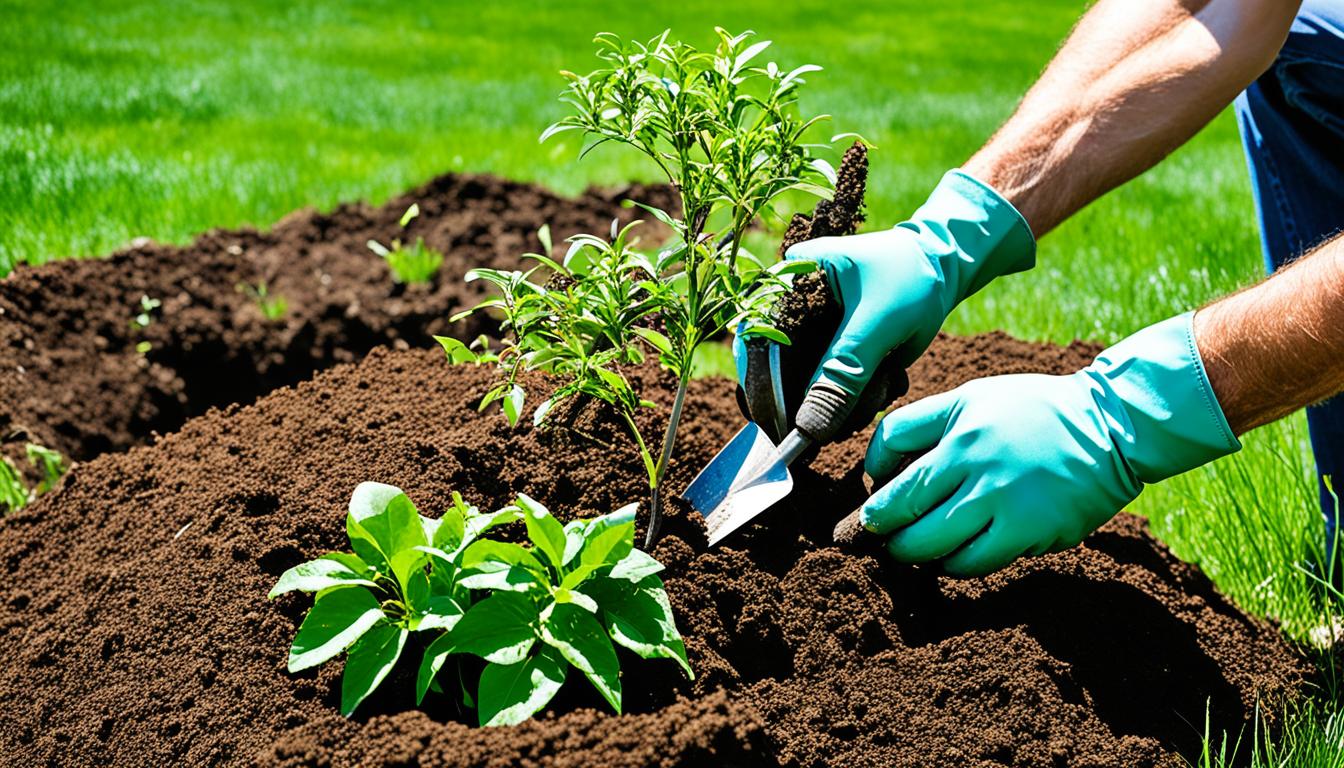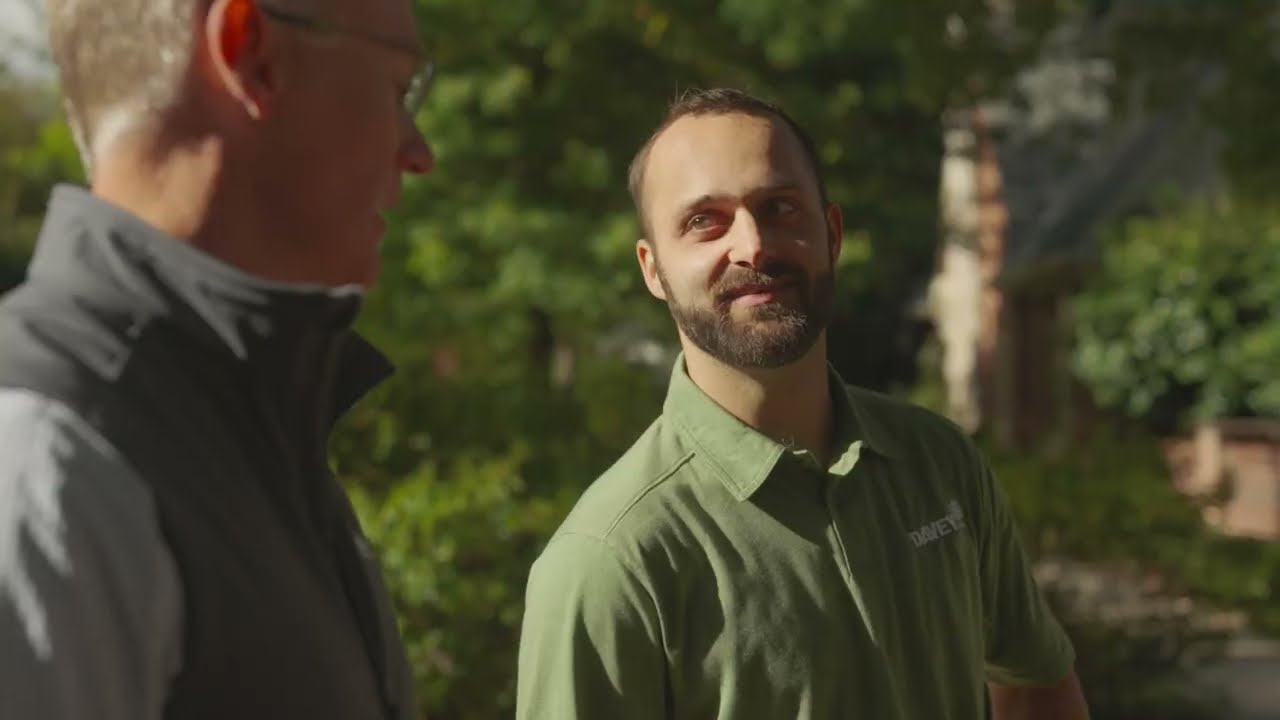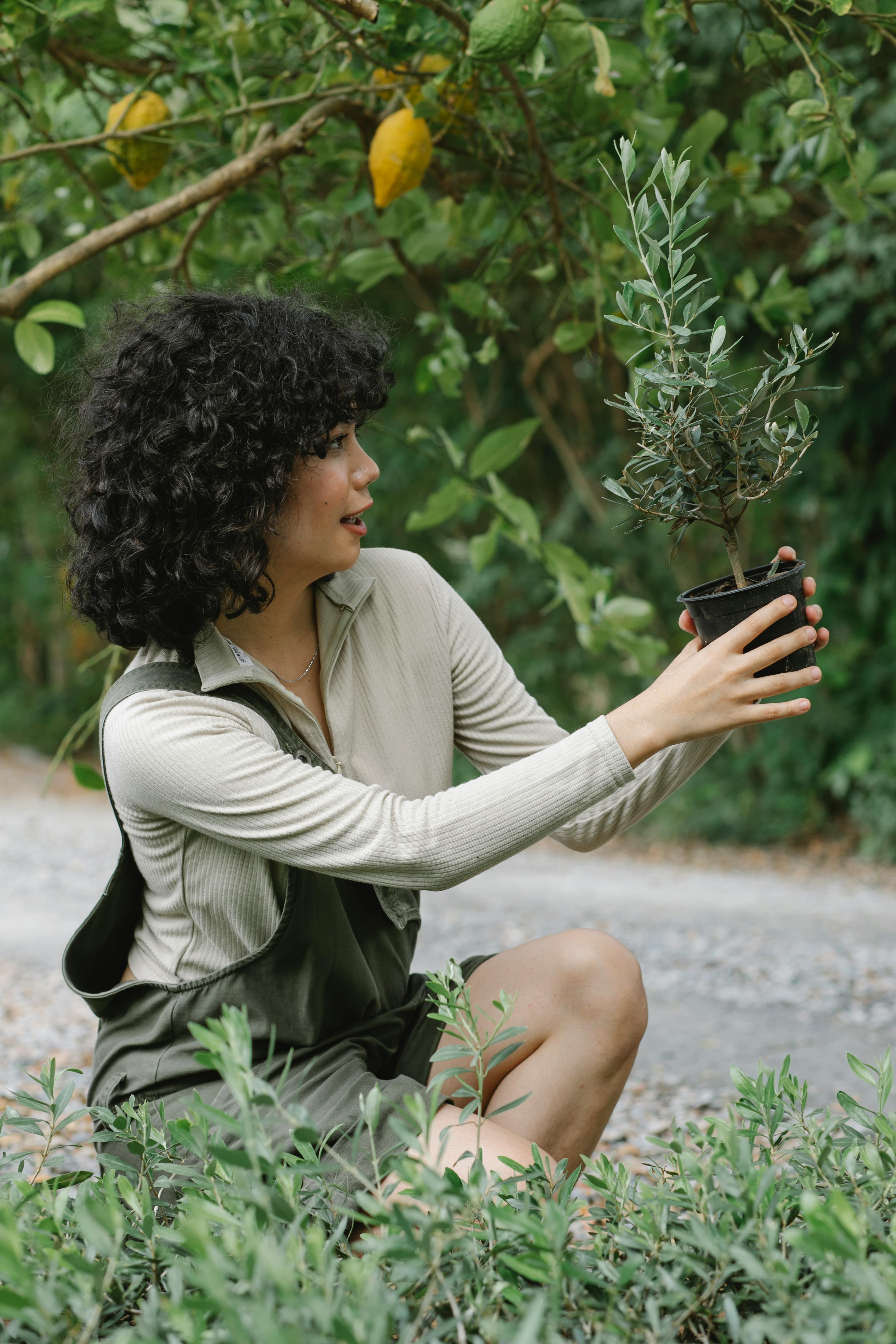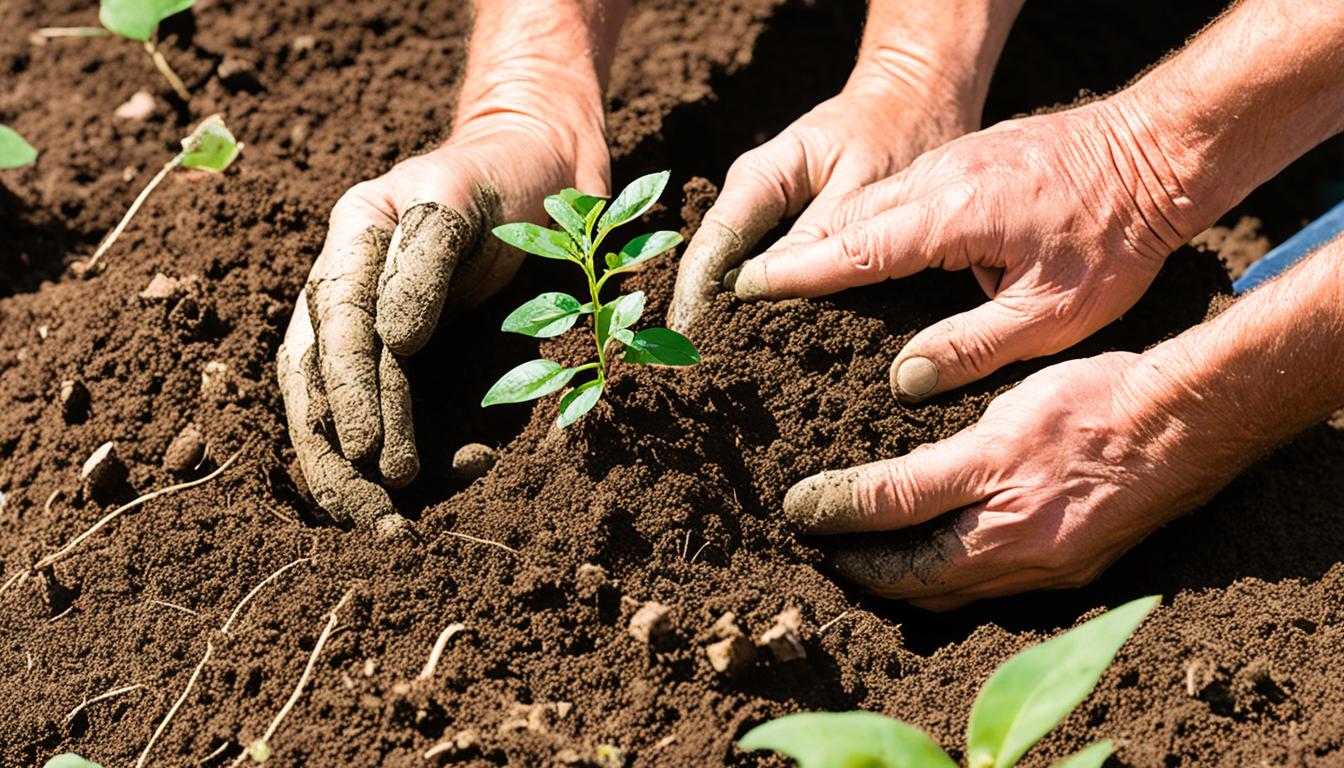Did you know that planting a single tree can remove up to 48 pounds of carbon dioxide from the atmosphere each year? That’s the equivalent of driving a car for 26,000 miles!
Tree planting is not only a beautiful addition to your landscape but also a powerful way to combat climate change and create a healthier environment for future generations.

Key Takeaways:
- Planting trees contributes to a greener and healthier community.
- The best time to plant trees is typically in the fall or spring.
- Proper tree maintenance is essential for long-term growth.
- Trees provide numerous benefits, including improving air quality and reducing energy costs.
- Choosing the right tree for your yard involves considering factors like tree species, growth rate, and local climate conditions.
Benefits of Planting Trees
Trees play a crucial role in enhancing our environment and improving our overall well-being. Planting trees not only beautifies our surroundings but also provides a wide range of benefits that are vital for a sustainable future.
- Improved air quality: Trees act as natural air filters, absorbing harmful pollutants and releasing oxygen. They help combat air pollution and create a cleaner, healthier atmosphere for us to breathe.
- Reduced energy costs: Strategically planted trees provide shade, reducing the need for excessive air conditioning during hot summers. By mitigating heat island effects, trees help lower energy consumption and save on utility bills.
- Mitigated climate change: Trees absorb carbon dioxide, a major greenhouse gas responsible for climate change. Through photosynthesis, trees store carbon and release oxygen, helping to stabilize our climate.
- Enhanced biodiversity: Trees provide essential habitats for a diverse range of species, including birds, insects, and other wildlife. By planting trees, we support and restore ecosystems, preserving biodiversity and ecological balance.
- Protection from extreme weather: Trees act as natural buffers against strong winds, heavy rains, and storms. They help prevent soil erosion, protect against flooding, and maintain stability in vulnerable areas.
- Beautification and community pride: Trees enhance the aesthetics of our neighborhoods, parks, and urban spaces. They create green spaces that connect people with nature, fostering a sense of pride, tranquility, and well-being.
By recognizing the importance of trees and actively participating in tree planting initiatives, we can build greener and healthier communities while contributing to a sustainable environment. Plant a tree today and be a part of the positive change.

Case Study: The Impact of Urban Trees
| City | Number of Urban Trees | Average Air Quality Improvement (%) | Energy Cost Reduction (per annum) |
|---|---|---|---|
| Vancouver, BC | 250,000 | 14% | $4.5 million |
| Toronto, ON | 350,000 | 17% | $7.2 million |
| Montreal, QC | 200,000 | 12% | $3.8 million |
| Calgary, AB | 180,000 | 11% | $2.9 million |
This case study illustrates the significant positive impact of urban trees on air quality improvement and energy cost reduction in major Canadian cities. By investing in tree planting initiatives, these cities have experienced substantial environmental and economic benefits.
Choosing the Right Tree for Your Yard
When it comes to selecting a tree for your yard, it’s important to consider your goals and preferences. Do you want a tree that adds beauty with its vibrant flowers? Or perhaps you’re looking for a tree that provides ample shade during the hot summer months. Maybe you even want a tree that bears delicious fruits. Whatever your preference, there are a few key factors to keep in mind to ensure you choose the best tree for your yard.
1. Determine Your Desired Tree Type
First and foremost, identify the type of tree you desire for your yard. Are you interested in a flowering tree that bursts with color and fragrance? Or do you prefer a shade tree that offers relief from the sun’s heat? Alternatively, you might be in search of a fruit tree that not only enhances the aesthetics of your yard but also provides a delicious harvest.
2. Research Trees That Thrive in Your Area
Next, conduct some research to identify the types of trees that thrive in your particular neighborhood and local parks. By observing the trees around you, you can get a sense of what species are well-suited to your region’s climate, soil conditions, and moisture levels. Consulting with local arborists or reaching out to gardening associations can also provide valuable insights.
3. Consider Size, Growth Rate, and Canopy
When choosing a tree, it’s crucial to take into account its size, growth rate, and canopy. Consider the available space in your yard and ensure the tree you select will have ample room to grow. Keep in mind that some trees may have extensive root systems that could interfere with nearby infrastructure, so be mindful of their potential impact.
4. Assess Leaf Color and Evergreen Options
Leaf color can add visual interest to your yard throughout the year. Some trees have leaves that change color in the fall, while others maintain their vibrant hues all year round. Additionally, if you prefer a tree that remains green year-round, consider evergreen options.
5. Account for Local Climate and Soil Conditions
Lastly, it’s vital to select a tree that can thrive in your local climate and adapt to the soil conditions in your area. Some trees are more tolerant of drought or excessive moisture, while others may require specific soil pH levels. Understanding your region’s climate and soil characteristics will help you make an informed choice.
| Tree Type | Benefits | Examples |
|---|---|---|
| Flowering Trees | Enhances visual appeal, attracts pollinators | Dogwood, Magnolia, Cherry Blossom |
| Shade Trees | Provides relief from sun’s heat, lowers cooling costs | Maple, Oak, Birch |
| Fruit Trees | Yields delicious produce, adds beauty to the yard | Apple, Pear, Peach |
| Evergreen Trees | Maintains green foliage year-round, provides privacy | Cypress, Pine, Spruce |

By carefully considering your goals, researching suitable tree species, evaluating factors such as size and canopy, and accounting for local climate and soil conditions, you’ll be able to make an informed decision when choosing the right tree for your yard.
Steps for Planting a Tree
Planting a tree is an exciting and fulfilling endeavor that not only enhances the beauty of your surroundings but also provides numerous environmental benefits. To ensure the successful growth of your newly planted tree, it’s essential to follow a series of steps that include digging the hole, preparing the hole, preparing the tree, planting the tree, backfilling the hole, mulching, watering, and maintaining the tree.
Digging the Hole
The first step is to dig a hole that is three times wider than the root ball but no deeper. Use a shovel to carefully remove the soil, taking care not to damage any existing roots. The wider hole allows the roots to spread easily and establish a strong foundation.
Preparing the Hole
After digging the hole, prepare the soil by loosening it to promote better root penetration and water drainage. Break up any clumps and remove any glazing on the sides of the hole, as this can hinder root growth.
Preparing the Tree
Before planting the tree, it’s important to inspect the root ball. Loosen any tangled or bound roots gently, as this encourages healthy growth. Remove any bindings or wires around the trunk, as they can inhibit the tree’s development.
Planting the Tree
Carefully place the tree in the center of the hole, ensuring that it is straight and upright. The top of the root ball should be level with the ground or slightly above. Backfill the hole with the soil, firming it gently to eliminate any air pockets. Avoid compacting the soil too tightly, as this can restrict root growth.
Mulching
Once the tree is planted, apply a layer of mulch around the base. Mulch helps retain moisture, regulate soil temperature, and prevent weed growth. Spread the mulch evenly, making sure to keep it a few inches away from the tree trunk to prevent rotting.
Watering and Maintaining the Tree
After planting, thoroughly water the tree to settle the soil and provide essential hydration. Water regularly, especially during the first growing season, to ensure proper root establishment. Monitor the tree’s moisture levels and adjust your watering schedule accordingly. In addition to watering, it’s crucial to maintain the tree by pruning any damaged or diseased branches, providing support with stakes if necessary, and fertilizing as recommended.

Following these steps will help ensure the successful growth and long-term health of your newly planted tree. By dedicating the time and effort to properly plant and maintain your tree, you’ll be rewarded with years of beauty and environmental benefits.
Conclusion
Planting trees is a rewarding experience that benefits both individuals and the environment. Whether you want to enhance the beauty of your yard, create shade, or contribute to a greener community, tree planting is a simple yet impactful way to make a difference. By following a few essential tree planting tips, you can ensure the success and longevity of your trees.
First and foremost, it’s crucial to choose the right tree for your yard. Consider factors such as the tree’s growth habit, size, and suitability to your local climate. Research the different types of trees available, from flowering ones to fruit-bearing or evergreen varieties, and select the one that best meets your goals and preferences.
Once you have selected the tree, follow the proper planting techniques. Dig a hole that is wide enough for the root ball to establish strong roots, but avoid digging too deep. Backfill the hole with the appropriate soil, ensuring good contact with the roots. Don’t forget to apply a layer of mulch around the base of the tree to conserve moisture and suppress weeds.
To maintain the health and growth of your newly planted tree, proper care is essential. Water the tree regularly, especially during the first growing season, to help establish its roots. Prune any damaged or diseased branches and provide adequate support if necessary. Stay vigilant for signs of pests or diseases and take action promptly if needed.
For all your tree planting and care needs, you can rely on Buck’s Tree Service. Their team of experienced professionals is dedicated to providing top-quality tree services, including planting, pruning, and maintenance.
Contact Buck’s Tree Service today and take the first step toward creating a greener and healthier environment by planting a tree in your own backyard.
FAQ
The best time to plant a tree is typically in the fall or spring when soil temperatures are suitable for root development.
Planting trees provides numerous benefits, including improving air quality, reducing energy costs, mitigating climate change, enhancing biodiversity, and providing shade and habitat for wildlife.
When choosing a tree for your yard, consider factors such as your goals and preferences, the trees that thrive in your local area, size, growth rate, leaf color, canopy, and suitability to your climate, soil, and moisture conditions.
To plant a tree successfully, start by digging a hole that is three times wider than the root ball but no deeper. Prepare the hole by loosening the soil and removing any glazing. Prepare the tree by loosening the root ball and removing any bindings. Plant the tree at the proper depth, backfill the hole with soil, mulch around the tree, and water the tree regularly, especially during its first growing season.
Proper tree maintenance includes mulching, watering, staking, pruning, and fertilizing. These practices are essential for the long-term growth and health of the tree.
For more tree planting tips and advice, you can contact Buck’s Tree Service. They are committed to helping you with all your tree planting and care needs.

